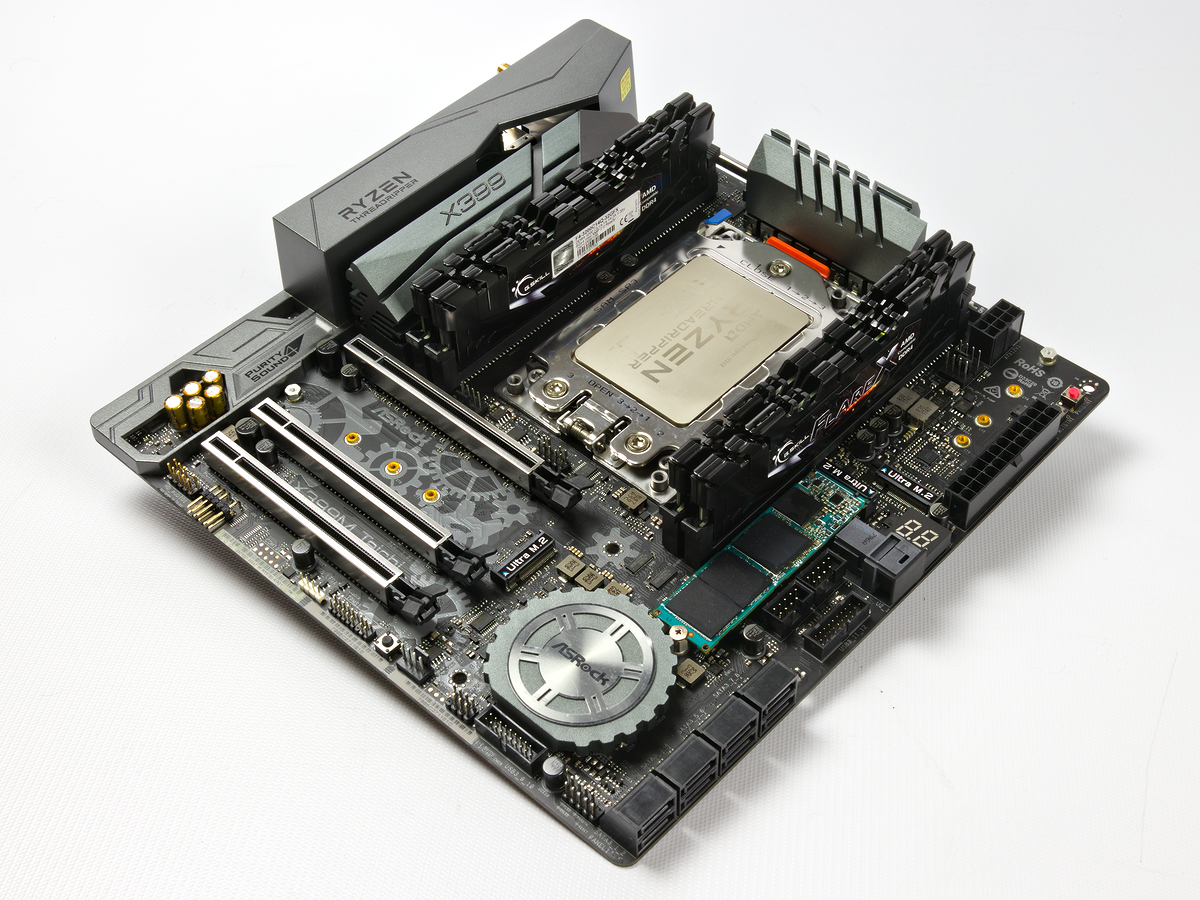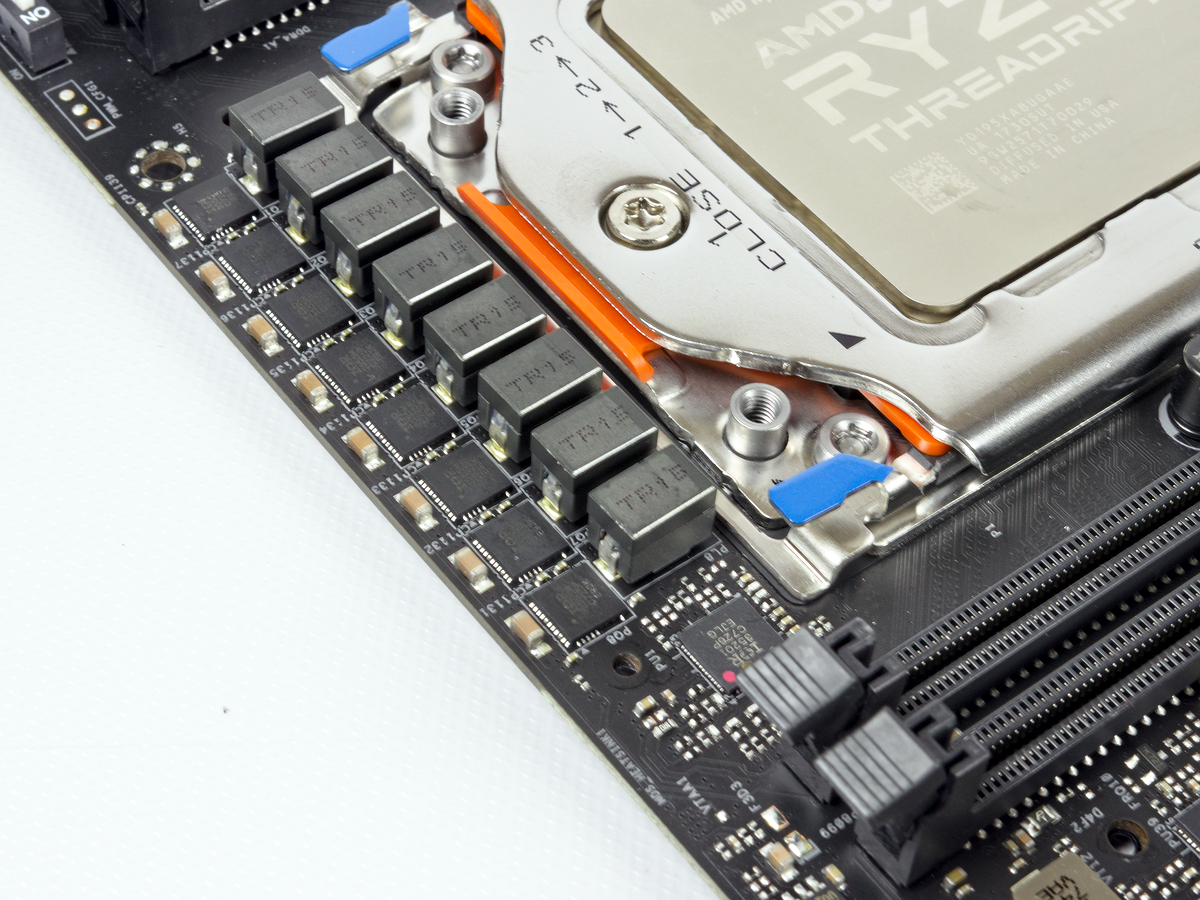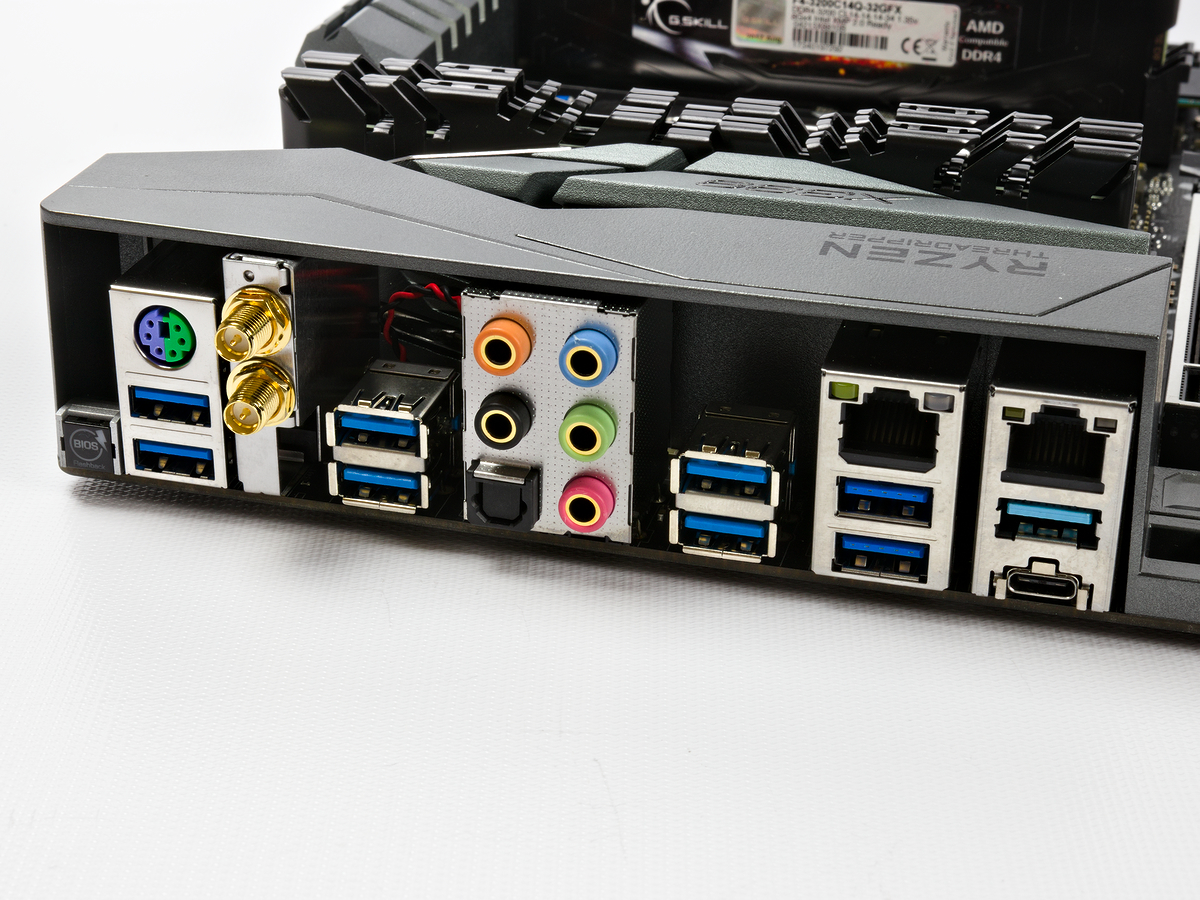Tom's Hardware Verdict
Steering away from the classic X399 mindset, the ASRock X399M Taichi delivers a unique and impressive entry point into the AMD HEDT world. It's also a good value while enthusiasts access to lots of cores in a small form factor.
Pros
- +
Great value for what you get
- +
Good overclocking potential
- +
Performance exceeds that of bigger boards
Cons
- -
Smaller size means fewer slots and internal ports
- -
250W CPU support limited to lighter overclocking
Why you can trust Tom's Hardware
Layout and Features
Despite its surprising combination of a compact Micro-ATX form factor and well-established powerhouse X399 chipset, the ASRock X399M (currently $299 / £233 on Newegg, with an extra $20 / £30 rebate to sweeten the deal) delivers spot-on performance in line with larger boards. And there’s plenty of potential for overclocking if that’s your thing. However, those looking for the monster Threadripper build experience with loads of graphics cards and high-speed storage should look elsewhere.
We’ve tested the other X399 motherboard offerings from ASRock, including full-size Taichi and Fatal1ty models, in previous reviews and have seen comparable performance, overclocking, and feature sets across the product stack. The last ASRock Threadripper board to land on our test bench was the X399M Taichi. So when we received the box for the X399M we were at first perplexed about the board's size.
On paper, X399 screams for extra memory modules, lots of PCIe cards, and loads of storage connectors to make a monster of a workstation or pro-sumer production rig. So why would we intentionally pick a product that sacrifices many of those critical components and slots to fit in a small case? In order to cram the cores of both the 1000- and 2000-generation Threadripper CPUs into a smaller form factor, IO has to be sacrificed, without neglecting power delivery and cooling capability for AMD's powerful-power-hungry Threadripper CPUs. But ASRock still manages to squeeze quite a bit into the 9.6 x 9.6-inches of board space here. First, let's take a look at the specs.
Specifications
| Socket | TR4 |
| Chipset | AMD X399 |
| Form Factor | Micro ATX |
| Voltage Regulator | 8+3 Phases |
| Video Ports | ✗ |
| USB Ports | 10Gbps:(1) Type A, (1) Type C5Gb/s: (8) Type A |
| Network Jacks | (2) Gigabit Ethernet |
| Audio Jacks | (5) Analog, (1) Digital Out |
| Legacy Ports/Jacks | (1) PS/2 |
| Other Ports/Jack | (2) SMA Antenna, (1) BIOS Flashback |
| PCIe x16 | (3) v3.0 (x16/x16/x16) |
| PCIe x8 | ✗ |
| PCIe x4 | ✗ |
| PCIe x1 | ✗ |
| CrossFire/SLI | 4x / 4x |
| DIMM slots | (4) DDR4 |
| M.2 slots | (1) PCIe v3 x4 / SATA3 42/60/80/110mm(1) PCIe v3 x4 / SATA3 42/60/80mm(1) PCIe v3 x4 / SATA3 30/42/60/80mm |
| U.2 Ports | (1) PCIe v3 x4, SFF-8639 (disable M2_1) |
| SATA Ports | (8) 6Gb/s |
| USB Headers | (2) 5Gb/s Type-C, (2) USB 2.0 |
| Fan Headers | (5) 4-Pin |
| Legacy Interfaces | ✗ |
| Other Interfaces | (1) RGB-LED, (2) Front panel Audio, (1) TPM |
| Diagnostics Panel | Numeric |
| Internal Button/Switch | CMOS Clear, Power, Reset, Xtreme OC |
| SATA Controllers | Integrated (0/1/5/10) |
| Ethernet Controllers | (2) Intel® I211AT |
| Wi-Fi / Bluetooth | Intel® 802.11ac WiFi Module, Bluetooth 4.2 / 3.0 |
| USB Controllers | ✗ |
| HD Audio Codec | ALC1220 |
| DDL/DTS Connect | ✗ / Yes |
| Warranty | 3 Years |



ASRock's design acumen is in overdrive on this board, no-doubt aided by the company's experience building Mini-ITX boards for the more mainstream / consumer market. By sacrificing half of the DIMM slots (which still leaves you with four), the socket can be shifted towards the back panel to squeeze in the M.2 drives that are critical for high-performance storage drives and arrays. Also, PCIe slots are either removed or squeezed on the bottom half of the board, which limits dual-slot graphics card deployments to just two. On the surface, this appears to be a no-go for serious X399 builders. But for an average builder, populating four DIMM slots and two graphics card slots is probably pushing the limits of a reasonable build budget--especially given the high price of RAM and Nvidia's 20-series GPUs. Plus, SLI / Crossfire builds are supported less-and-less these days, both by developers and Nvidia / AMD. So maybe we could look at the ASRock X399M Taichi as the perfect entry-level X399 board?




The X399M sports the same voltage regulator (Vreg) components as the Taichi and Fatal1ty boards, while shifting the alignment of the heat spreader to accommodate the ATX mounting screws and reduced distance of the bend around the DIMM slots. This is a great feature from a raw power delivery perspective, but the same Vreg cooling issues we’ve seen on previous boards are carried over as well. We'll revisit power delivery in our overclocking section, but for the most part, this design works.


With eight USB 3.1 5Gbps (Gen1) ports, two USB 3.1 10Gbps (Gen2, one Type-A, one Type-B) ports, two gigabit Ethernet jacks, five analog and one digital audio port, a PS/2 port and connections for SMA Wi-Fi antennas, the lack of sacrifices for X399M back-panel implementation should be a relief to content creators or other accessory-laden users. Despite the reduced planar size, two USB 5Gbps, two USB2.0, one RGB, and five 4-pin fan headers are available on the board which, despite its smaller size, favors full-sized case configurations. This Micro-ATX board is starting to sound more and more enticing.




Other notable inclusions for the X399M Taichi are the Purity Sound 4 (essentially premium audio circuitry, capacitors and shielding) and the ALC1220 codec (just like the full-size Taichi), built-in Intel AC-Wireless, and overclocking-friendly features like power / reset buttons and an Xtreme OC switch.
Get Tom's Hardware's best news and in-depth reviews, straight to your inbox.
As we mention above, the X399 standard inclusion of three M.2 slots are available here, but laid out a bit differently than the larger X399M’s sibling boards. Also, U.2 remains on the board with similar stipulations, such that connecting U.2 disables the M2_1 socket. Eight SATA 6Gbps ports are available through right-angled brackets, though clearance with smaller chassis could be problematic.


To pull a few universal complaints most every Mini-ITX review: Cramped spaces are certain to be a sticking point for some builders. Important fan and EPS connectors are tightly crammed together, which makes installation into smaller chassis even more of a challenge. The Dr. Debug LED is shifted from the bottom-right quadrant to above the 24-pin ATX header, which might be hard to see in some board orientations. Power and reset buttons are available, but they're tiny. Lastly, the reduced real estate leaves the board looking slightly boring by “gamer” standards, but a subtle glow below the chipset heatsink does provide the user with customizable coloration.
Typically, we cover the UEFI of a product in its own page in an article, but little has changed on the ASRock X399 front here. Those looking for BIOS details should check out the Taichi and Fatal1ty UEFI pages for a close look at the menus and options.
MORE: Best Motherboards
MORE: How To Choose A Motherboard
MORE: All Motherboard Content
